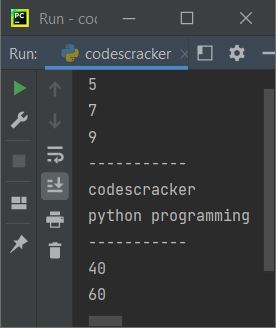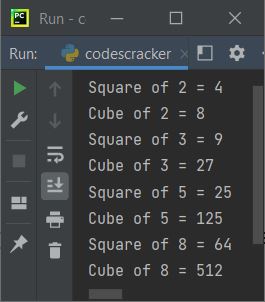- Python Built-in Functions
- Python All Built-in Functions
- Python print() Function
- Python input() Function
- Python int() Function
- Python float() Function
- Python len() Function
- Python range() Function
- Python str() Function
- Python ord() Function
- Python chr() Function
- Python ascii() Function
- Python pow() Function
- Python type() Function
- Python List Functions
- Python list() Function
- Python insert() Function
- Python append() Function
- Python extend() Function
- Python pop() Function
- Python remove() Function
- Python reverse() Function
- Python sort() Function
- Python sorted() Function
- Python Dictionary Functions
- Python dict() Function
- Python update() Function
- Python get() Function
- Python keys() Function
- Python setdefault() Function
- Python fromkeys() Function
- Python items() Function
- Python popitem() Function
- Python Tuple Function
- Python tuple() Function
- Python Set Functions
- Python set() Function
- Python frozenset() Function
- Python String Functions
- Python split() Function
- Python join() Function
- Python format() Function
- Python replace() Function
- Python Iterator Functions
- Python iter() Function
- Python min() Function
- Python max() Function
- Python sum() Function
- Python count() Function
- Python index() Function
- Python copy() Function
- Python clear() Function
- Python next() Function
- Python filter() Function
- Python enumerate() Function
- Python zip() Function
- Python reversed() Function
- Python Number Functions
- Python abs() Function
- Python bin() Function
- Python oct() Function
- Python hex() Function
- Python round() Function
- Python divmod() Function
- Python complex() Function
- Python File Handling Functions
- Python open() Function
- Python read() Function
- Python readable() Function
- Python readline() Function
- Python readlines() Function
- Python write() Function
- Python writable() Function
- Python writelines() Function
- Python close() Function
- Python seek() Function
- Python tell() Function
- Python flush() Function
- Python fileno() Function
- Python truncate() Function
- Python Class Functions
- Python object() Function
- Python property() Function
- Python getattr() Function
- Python setattr() Function
- Python hasattr() Function
- Python delattr() Function
- Python classmethod() Function
- Python staticmethod() Function
- Python issubclass() Function
- Python super() Function
- Python Misc Functions
- Python all() Function
- Python any() Function
- Python isatty() Function
- Python bool() Function
- Python callable() Function
- Python globals() Function
- Python locals() Function
- Python dir() Function
- Python id() Function
- Python isinstance() Function
- Python map() Function
- Python repr() Function
- Python slice() Function
- Python vars() Function
- Python Advance Functions
- Python help() Function
- Python hash() Function
- Python breakpoint() Function
- Python bytes() Function
- Python bytearray() Function
- Python memoryview() Function
- Python compile() Function
- Python eval() Function
- Python exec() Function
- Python Tutorial
- Python Tutorial
- Python Examples
- Python Examples
Python map() Function
The map() function in Python is used when we need to execute a function for each item in an iterable, where item is passed as argument of the function. For example:
def cubes(n): return n*n*n mylist = [2, 3, 4, 5] res = map(cubes, mylist) for x in res: print(x)
The output will be:
8 27 64 125
Python map() Function Syntax
The syntax of map() function in Python, is:
map(fun, iterables)
where fun refers to the function that needs to be executed for each items of specified iterable. Whereas iterables refers to a sequence, a collection or items, or an iterator object.
Note: Any number of iterables can be used.
Point to be Noted - The function has one parameter for each iterable.
Python map() Function Example
Here is an example of map() function in Python:
def add(x, y): return x + y a = [1, 2, 3] b = [4, 5, 6] for x in map(add, a, b): print(x) print("-----------") a = ("codes", "python ") b = ("cracker", "programming") for x in map(add, a, b): print(x) print("-----------") for x in map(add, (10, 20), (30, 40, 80)): print(x)
The snapshot given below shows the sample output produced by above program, demonstrating the map() function:

Let's create another program uses map() function to find squares and cubes of all numbers available in a list named mylist:
def square(x): return x*x def cube(x): return x*x*x mylist = [2, 3, 5, 8] resSq = map(square, mylist) resCu = map(cube, mylist) print(list(resSq)) print(list(resCu))
The output will be:
[4, 9, 25, 64] [8, 27, 125, 512]
Let's modify the above program to create an output that provides little good user-experience than previous one:
def square(x): return x*x def cube(x): return x*x*x mylist = [2, 3, 5, 8] resSq = list(map(square, mylist)) resCu = list(map(cube, mylist)) for i in range(len(mylist)): print("Square of", mylist[i], "=", resSq[i]) print("Cube of", mylist[i], "=", resCu[i])
Now the output is like shown in the snapshot given below:

« Previous Function Next Function »